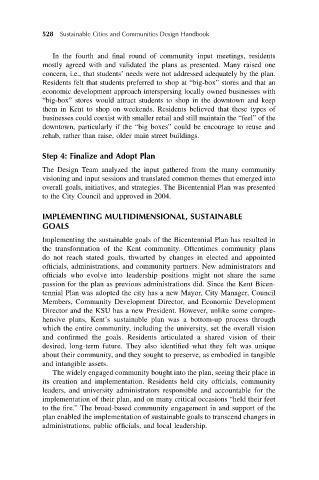Page 559 - Sustainable Cities and Communities Design Handbook
P. 559
528 Sustainable Cities and Communities Design Handbook
In the fourth and final round of community input meetings, residents
mostly agreed with and validated the plans as presented. Many raised one
concern, i.e., that students’ needs were not addressed adequately by the plan.
Residents felt that students preferred to shop at “big-box” stores and that an
economic development approach interspersing locally owned businesses with
“big-box” stores would attract students to shop in the downtown and keep
them in Kent to shop on weekends. Residents believed that these types of
businesses could coexist with smaller retail and still maintain the “feel” of the
downtown, particularly if the “big boxes” could be encourage to reuse and
rehab, rather than raise, older main street buildings.
Step 4: Finalize and Adopt Plan
The Design Team analyzed the input gathered from the many community
visioning and input sessions and translated common themes that emerged into
overall goals, initiatives, and strategies. The Bicentennial Plan was presented
to the City Council and approved in 2004.
IMPLEMENTING MULTIDIMENSIONAL, SUSTAINABLE
GOALS
Implementing the sustainable goals of the Bicentennial Plan has resulted in
the transformation of the Kent community. Oftentimes community plans
do not reach stated goals, thwarted by changes in elected and appointed
officials, administrations, and community partners. New administrators and
officials who evolve into leadership positions might not share the same
passion for the plan as previous administrations did. Since the Kent Bicen-
tennial Plan was adopted the city has a new Mayor, City Manager, Council
Members, Community Development Director, and Economic Development
Director and the KSU has a new President. However, unlike some compre-
hensive plans, Kent’s sustainable plan was a bottom-up process through
which the entire community, including the university, set the overall vision
and confirmed the goals. Residents articulated a shared vision of their
desired, long-term future. They also identified what they felt was unique
about their community, and they sought to preserve, as embodied in tangible
and intangible assets.
The widely engaged community bought into the plan, seeing their place in
its creation and implementation. Residents held city officials, community
leaders, and university administrators responsible and accountable for the
implementation of their plan, and on many critical occasions “held their feet
to the fire.” The broad-based community engagement in and support of the
plan enabled the implementation of sustainable goals to transcend changes in
administrations, public officials, and local leadership.

